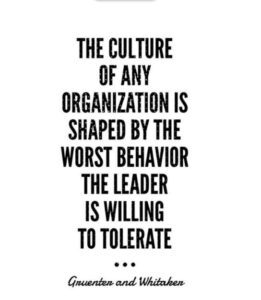The Big Question: What Makes Healthcare Workers Stay in Their Jobs?
“Getting back to basics is crucial — and in healthcare that means focusing organizational culture on the noble cause of reducing patients’ suffering and then supporting caregivers in that work.”
Are you firing enough people?
3-minute read
We’re not talking about the painful RIFs and layoffs that bedevil our industry when times are tough, as they are now.
We’re talking about those singular bad apples who can spoil your Herculean efforts to boost morale, strengthen your culture and keep your nurses coming back to work shift after shift.
For all the appropriately intense focus today on workforce retention, it is likely that sometimes – regretfully, unfortunately, but candidly – the best thing you can do for your team is to make it one member less.
Cutting someone loose is always your last option. But a pair of shears must be in your culture-growing toolbox.
Last week, the Harvard Business Review asked “What makes health care workers stay in their jobs?” If you’ve lingered long around the nurse’s station, you know the answers.
“Our data on hundreds of thousands of physicians, nurses, and other caregivers…shows that pride in their work and loyalty to their colleagues are the strongest correlates of their readiness to stay with their organization and continue showing up for work,” the authors write.
“Competitive pay and other support options are essential to recruiting caregivers, of course, but organizational culture, including a commitment to excellence, is what makes them stay.”
Pride. Loyalty to colleagues. Culture. The article emphasizes quality leadership at every level and a strong organizational culture as foundational elements to maintaining morale and hanging on to precious healthcare workers.
You know the relentless, hard work this demands. Harder still if you have a disruptive individual – a staff member, a nurse, a physician – whose behavior actively undermines your constructive efforts.
An older study in The Wall Street Journal said the risk of keeping the deadbeats, downers and jerks is something on the order of a 30 to 40-percent drop in team performance. Forty percent. Why? Psychologist researcher Roy Baumeister simply said: “Bad is stronger than good.”
A few thoughts:
 Everyone is a message. Healthcare leaders rightly invest significant time and money today on the development of their employee experience. Often the hardest element of this work is the experience created and shared among peers and colleagues. A culture isn’t merely built – or broken – vertically, but horizontally as well. It’s formed (and deformed) collectively.
Everyone is a message. Healthcare leaders rightly invest significant time and money today on the development of their employee experience. Often the hardest element of this work is the experience created and shared among peers and colleagues. A culture isn’t merely built – or broken – vertically, but horizontally as well. It’s formed (and deformed) collectively.
Allowing bad apples to thrive is a corrosive counter to your culture-building and, ultimately, to your leadership credibility. It causes the staff who are laboring to hold themselves to the high standards you say you expect, to ask themselves: “Why bother trying?” and “Why should I give credence to any other directives from leadership?”
It has been said: “The culture of any organization is shaped by the worst behavior the leader is willing to tolerate.” It’s true.
But here’s the good news: Acting when you must sends a powerful message, too — that what you say matters and that your commitment to the culture you’ve defined is consequential.
Be aware of the story you’re telling through the behavior you allow and elevate. Know, too, that your audience is everyone and that everyone is watching, always.
Invest in your nurse leaders as communicators. As our nurse survey and the HBR article show, the relationships that matter most among nurses and staff are with their managers, in the trenches. Good communication and well-equipped leaders on the floor are the most influential, most compelling messengers to your valuable colleagues and the best scouts for shaping your culture and ensuring staff retention.
Help them listen well and be equipped to have the tough conversations when those are necessary. Help them with all the cliches’: To nip bad things in the bud, to head worse off at the pass, to bring light to the darkness and nurture the ties that bind.
Empowered managers, trained at helping everyone be successful and at addressing problems early and often, are the best defense against disruptive colleagues. But sometimes, that’s not enough…
Know when to draw the line. A strong culture, training, and compassionate and thorough interventions are the first – and best – steps to take with a problematic colleague. But eventually, enough is enough.
When it’s time, ensure that your organization’s values and behavioral expectations are clearly defined and clearly communicated and that your performance management processes are current and socialized.
These foundations will be particularly valuable when you face the inevitable “yes, but” grey area as you approach a dismissal – your internal debate over an operationally performing but culturally toxic colleague, for example.
Your stated standards can help relieve the action-neutralizing angst and, sometimes, the personal sense of failure that can accompany the heart work of hard calls. “Thus, conscience does make cowards of us all,” as Hamlet mused.
Follow the rules. We’re communications experts, not employment lawyers or HR gurus. In all of this, work closely with the leadership in your organization to adhere to the rules, policies and culture of your organization.
You are in a battle for talent. Recruiting and retaining the best colleagues is a strategic priority and there is much to this complex, organic work that stretches from your department to the further reaches of your organization.
Making the tough call to prune a bad apple from your tree can be uncomfortable. If you care, it should be and should be compassionately considered and carefully done. Yet, it may be precisely the thing that keeps your best people with you and, well, fruitful.
Contributors: Courtney Tedesco, Kevin Kearns, Ann Cannon, David Shifrin, Emme Baxter
Image credit: Shannon Threadgill



